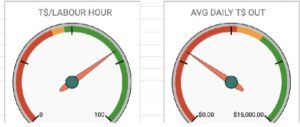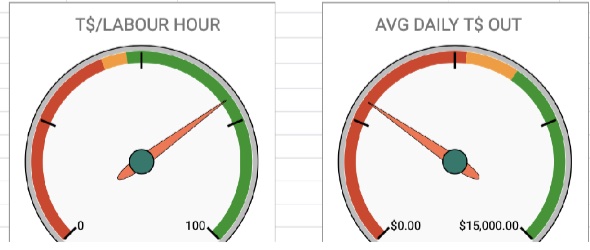Lean at its core could be summed up as continuous improvement through the
elimination of waste. So we wage war against waste trying to identify it and
eliminate it. Some of it’s easy to see and get rid of or at least reduce, and
typically team members can be doing that on the shop floor by making simple
improvements to their work area or their process. There are a huge gains to be
made having your whole team engage like this and we highly recommend Setting
aside time to let them do this.
But let’s face it, you have some bigger problems! And wouldn’t it be nice to start
knocking some of those off your list?
Here’s a formula that should jumpstart your problem-solving activity.
Measure it; assign it; monitor it; improve it. REPEAT.
Now before we delve into each step I hazard to say solving what we would
classify as big problems are because we want to move the bottom line. And
most businesses have four measurements that you’re probably already tracking .
Cost of goods sold
Overhead
Labour
Profit / loss.
We want to see the first three going down and the last one going up. Although as
management these are the measurements we look at, running around yelling
reduce overhead is going to have a net zero effect. So how can we set this up
for maximum effectiveness. Let’s go !
Step 1: gather your leadership team. One stakeholder from each department
should suffice. This should be a daily stand up huddle, and should not drag out,
30 min or less.
Step 2. Establish measurables. This part can be tricky and take a lot of thought.
Keep in mind the old saying “tell me how you measure me, and I’ll tell you how I
behave“. This measurable Has to be specific and The person it’s assigned to
must be able to influence those numbers.
Step 3. Assign your specific measurables to the person on your leader ship team
who is a stakeholder in that area. Now they are solely responsible for moving
that dial in the right direction.
Step 4. Have each member of your
leadership team present their
dashboard to the group each day. Preferably a graphical representation green yellow
and red. If their arrows are in the red simply ask what’s the plan?
If they need any help or assistance they’re standing there with your entire
leadership team to brainstorm.
Step 5. IMPROVE ! this is the fun part. Every time a needle is in the red or
yellow your whole team can rally around a single purpose of fixing that problem.
Warning: you have to create a very safe place or people will not tell you about
their problems. And they may even be a little nervous in the beginning so
whoever comes to the table 1st with a real problem to solve or an accurate
measurement on poor performance celebrate that and show the rest of your
team that’s why you’re there, not to assign blame but to solve problems.
I will repeat a famous quote in the lean world “Smart people can’t believe its this
simple”. Most people are wonderful problem solvers and eager to help the
company. If your rolling your eyes thinking, thats not my case, and they are on
your leadership team, Ummm you may want to set them free to bother some
other business owner.
Let’s begin with a few lessons learned to help jumpstart your leadership huddle.
Be patient, it will take some time, thinking and trying different things to make the
meeting effective, but it will happen. When you feel it’s not effective, don’t be
shy. Say “Hey team, I’m not feeling the value here, how can we make this more
productive”
Be intentional, if you get busy and miss the meetings, they will lose value and
slowly fizzle out.
Be relentless! If you’re facilitating the meeting, don’t let people off the hook. Ask
the tough questions. If they don’t have an answer, which in the beginning may
be the case, after the meeting let them know you expect them to have the
information. I’d recommend not doing this in front of the group, but when
someone does have great information or brings to light a real problem in their
area, pour on the praise in front of everyone. The old saying “Praise in public,
punish in private”
The show must go on. If one or more people can’t make it, don’t cancel it. Have
the others take notes and send them to the missing people. The message must
be clear, we are getting together daily to solve problems!
Make measurements reflect reality. This may involve doing daily, weekly,
monthly, quarterly andyearly metrics. Also helpful is to do rolling time periods, 5
weeks is usually good. But if you only monitor monthly or yearly, you won’t see
the arrows moving because of a small improvement effort. Important to capture
data that will move the needle within a couple of days.
Last but not least, a few words on measuring, this will absolutely be the most
challenging part. We are all familiar with the 5 – why’s. Measuring is similar, but
use the 5-whats to help guide you.
Example: I want to reduce my material cost. You can’t say “hey everyone,
reduce our material cost”. No one will know where to start. But if you give a
clear directive, magic will happen.
WHAT effects material cost the most? how many sheet goods we use.
WHAT effects how many sheet goods we use? How effective are our CNC
layouts
WHAT determines how effective our CNC layouts are? How many parts per
sheet.
Now you have something in the control of your team and something you can
create a metric around. “Average parts per sheet”.
Track it for a week, then put someone in charge of improving the metric. Im
already reading your mind “I have software that does that”. Yup, and I still
challenge people to improve it, check the settings, monitor scrap for better
yield… don’t shut it down before it begins, you never know what awesome ideas
you team will come up with.
Measuring is always tricky, if you need some help with it, feel free to reach out to
us anytime. Now, get your team together and solve those BIG problems.
